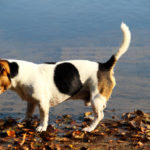Short-legged Jack Russell Vs Long-legged
The Jack Russell Terrier is a well-known and beloved breed that has gained popularity worldwide. Within the Jack Russell Terrier family, there are distinct variations in leg length, commonly referred to as short-legged and long-legged Jack Russells.
In this blog post, we will delve into the world of the taller version (now the AKC Parson Russell Terrier, as well as the JRTCA Jack Russell Terrier), exploring their origins, physical traits, temperament, exercise needs, and more. Whether you’re a dog lover considering adding one of these breeds to your family or simply interested in learning more, this article will provide valuable insights into the fascinating world of the AKC Parson Russell Terrier and JRTCA Jack Russell Terrier.
The Long-Legged Russells – The Parson Russell Terrier and Jack Russell Terrier
The Parson Russell Terrier and Jack Russell Terrier are two well-known dog breeds that have gained popularity among dog enthusiasts worldwide. While both breeds share similar origins and characteristics, there exists a distinct variation known as the taller version, recognized by the American Kennel Club (AKC) as the Parson Russell Terrier and by the Jack Russell Terrier Club of America (JRTCA) as the Jack Russell Terrier.
These taller versions of the beloved terrier breeds have their own unique features and qualities that set them apart.
Long-legged Jack Russell – Origins and Breed History
The Parson Russell Terrier and Jack Russell Terrier have their roots in fox hunting, originating in England during the 19th century. Reverend John “Jack” Russell, an avid sportsman and clergyman, played a pivotal role in the development of these breeds. He sought to create a small, agile, and fearless terrier that could efficiently hunt and flush out foxes.
Initially, the breed was referred to as the Jack Russell Terrier, named after its creator. The dogs were highly valued for their exceptional hunting skills and were selectively bred for their working abilities rather than adherence to a strict appearance standard.
Over time, the breed gained popularity not only for its hunting prowess but also as a charming and loyal companion. The breed’s popularity spread beyond hunting circles, and enthusiasts began breeding the dogs for show purposes, leading to variations in appearance and size.
Recognizing the need to preserve the breed’s working abilities while accommodating the preferences of show enthusiasts, two distinct organizations emerged: the AKC and the JRTCA. The AKC recognized the taller version as the Parson Russell Terrier, named in honor of Reverend Russell, while the JRTCA continued to refer to the breed as the Jack Russell Terrier, preserving the original name and characteristics.
The AKC and JRTCA differ in their breed standards for the taller version. The AKC places emphasis on conformation standards for show purposes, while the JRTCA prioritizes the breed’s working abilities, valuing their agility, intelligence, and hunting skills.
Today, both the AKC Parson Russell Terrier and the JRTCA Jack Russell Terrier have their dedicated enthusiasts and continue to thrive as beloved companion dogs, excelling in various canine activities such as obedience, agility, and earthdog trials.
In the next section, we will explore the specific breed standards and appearance of the taller version of these terriers.
Long-legged Jack Russells – Breed Standards and Appearance
The taller version of the Parson Russell Terrier (AKC) and Jack Russell Terrier (JRTCA) have distinct breed standards and appearances, reflecting their respective organizations’ goals and priorities.

a. AKC Parson Russell Terrier
The AKC recognizes the taller version as the Parson Russell Terrier and has established specific breed standards for this variation. Here are some key characteristics:
- Height: The AKC standard specifies a height range of 13 to 14 inches (33 to 35.5 cm) at the withers for males and females.
- Proportions: The Parson Russell Terrier has a balanced and athletic build, with a body length slightly longer than its height. The chest is deep, and the overall structure should be well-muscled and sturdy.
- Coat: The coat can be rough or smooth, both of which are accepted by the AKC. It should be weatherproof, dense, and close-fitting to the body.
- Colors: The AKC allows a variety of coat colors for Parson Russell Terriers, including white combined with black, tan, or a combination of both.
b. JRTCA Jack Russell Terrier
The JRTCA, on the other hand, has its own set of breed standards for the taller version, which it continues to refer to as the Jack Russell Terrier. Here are some notable characteristics:
- Height: The JRTCA standard sets the preferred height range for males and females at 10 to 15 inches (25.4 to 38 cm) at the withers, emphasizing a balanced and proportionate structure.
- Body Type: The Jack Russell Terrier should have a well-muscled, compact, and agile body, with a chest of moderate width and depth.
- Coat: Similar to the AKC standard, the JRTCA accepts both rough and smooth coats. The coat should be dense, harsh, and close-lying.
- Colors: The JRTCA recognizes a predominantly white coat with markings of tan, black, or brown. A symmetrical distribution of color is preferred.
Despite some differences in appearance, both the AKC Parson Russell Terrier and JRTCA Jack Russell Terrier share common traits that make them easily recognizable as part of the terrier family. Their small, sturdy frames, alert expressions, and distinctive terrier personalities contribute to their charm and appeal.
In the next section, we will explore the temperament and personality traits of the taller version of these terriers, shedding light on their distinct characteristics and behavior.
Temperament and Personality Traits

The taller versions of the Parson Russell Terrier (AKC) and Jack Russell Terrier (JRTCA) share many common temperaments and personality traits that make them spirited and endearing companions. Here are some key characteristics to consider:
a. High Energy Levels: The taller versions of these terriers are known for their boundless energy. They thrive on physical activity and mental stimulation, requiring regular exercise and playtime to keep them content and prevent behavioral issues.
b. Fearlessness and Courage: Bred as working terriers, both the AKC Parson Russell Terrier and JRTCA Jack Russell Terrier exhibit remarkable fearlessness and courage. They possess a strong prey drive and an instinctive desire to chase and hunt, which can manifest in their interactions with smaller animals.
c. Intelligence and Trainability: These terriers are highly intelligent and quick learners. They excel in various canine sports and activities that challenge their minds and bodies. However, their independent nature may sometimes require patient and consistent training methods to achieve desired results.
d. Alertness and Vigilance: The taller versions of these terriers are naturally vigilant and make excellent watchdogs. They have keen senses and are quick to alert their owners to any perceived threats or changes in their environment.
e. Socialization and Compatibility: Early socialization is crucial for the taller versions of these terriers to develop proper behavior around people and other animals. They can be friendly and affectionate with their families but may display assertiveness towards unfamiliar dogs or small animals due to their hunting instincts.
f. Devotion and Loyalty: Parson Russell Terriers and Jack Russell Terriers are known for their deep loyalty and devotion to their owners. They thrive on human companionship and require ample love, attention, and mental stimulation to prevent boredom and potentially destructive behavior.
It is important to note that individual personalities may vary within these breed traits. Early socialization, consistent training, and positive reinforcement are essential for nurturing well-rounded, balanced, and obedient dogs.
In the next section, we will explore the exercise and training needs of the taller versions of these terriers, providing insights on how to keep them mentally and physically stimulated.
Jack Russell Taller Version Exercise and Training Needs
The taller versions of the Parson Russell Terrier (AKC) and Jack Russell Terrier (JRTCA) are highly active and energetic breeds that require regular exercise and mental stimulation. Meeting their exercise and training needs is crucial for their overall well-being and to prevent behavioral issues. Here are some key considerations:

a. Physical Exercise:
- Daily Exercise: These terriers thrive on daily exercise routines. Aim for at least 30 to 60 minutes of vigorous exercise, such as brisk walks, jogging, or interactive play sessions.
- Engaging Activities: Incorporate activities that tap into their natural instincts, such as fetch, agility courses, or interactive toys that challenge their problem-solving abilities.
- Secure Environment: Ensure they are in a secure, fenced area or on a leash during outdoor activities, as their strong prey drive may lead them to chase small animals.
b. Mental Stimulation:
- Training Sessions: Engage their active minds through consistent and positive training sessions. Use reward-based methods and keep the training sessions short, varied, and fun to maintain their interest.
- Puzzle Toys and Games: Provide mentally stimulating toys and games, such as puzzle feeders or hide-and-seek games, to keep them mentally engaged and prevent boredom.
- Nose Work: These terriers excel in scent-based activities. Consider participating in activities like tracking or nose work, which tap into their exceptional olfactory abilities.
c. Obedience and Socialization:
- Start Early: Begin training and socialization from a young age to establish good behavior and manners. Expose them to various environments, people, and animals to ensure they become well-adjusted and confident adults.
- Consistency and Positive Reinforcement: Use positive reinforcement techniques, such as treats, praise, and rewards, to motivate and encourage desired behaviors. Consistency and patience are key to their training success.
d. Interactive Play and Bonding:
- Engage in interactive play sessions to strengthen the bond with your terrier. Play games like tug-of-war, hide-and-seek, or interactive toys that promote their physical and mental well-being.
- Provide ample opportunities for social interaction with other friendly dogs and supervised playdates to develop their social skills.
Remember, the taller versions of these terriers thrive on mental and physical stimulation. Failing to meet their exercise and training needs can lead to boredom, frustration, and potential behavioral issues. With consistent exercise, training, and mental enrichment, you’ll have a happy, well-rounded companion by your side.
In the next section, we will discuss health considerations for the taller versions of these terriers, including potential genetic disorders and recommended health screenings.
Long-legged Jack Russell Health Considerations

The taller versions of the Parson Russell Terrier (AKC) and Jack Russell Terrier (JRTCA) are generally robust and healthy breeds. However, like any dog breed, they may be prone to certain health issues. Understanding these potential concerns and taking proactive measures can help ensure the well-being of your terrier. Here are some key health considerations:
a. Genetic Disorders:
- Patellar Luxation: This condition involves the dislocation of the kneecap and can range from mild to severe. Regular veterinary check-ups and exercise moderation can help manage this condition.
- Legg-Calvé-Perthes Disease: It affects the hip joint, leading to degeneration of the femoral head. Early detection and appropriate medical interventions are essential.
- Lens Luxation: This condition occurs when the lens of the eye becomes detached, causing vision problems. Regular eye examinations can help identify and manage this condition.
b. Dental Health:
- Terriers, including the taller versions, are susceptible to dental issues such as tartar buildup, gum disease, and tooth loss. Establish a dental care routine that includes regular brushing, dental chews, and professional cleanings as recommended by your veterinarian.
c. Weight Management:
- Obesity can pose health risks for these terriers, impacting their overall well-being and predisposing them to joint problems. Provide a balanced diet, portion control, and regular exercise to maintain a healthy weight.
d. Health Screenings:
- Regular veterinary check-ups and health screenings are vital to monitor the general health of your terrier. Recommended screenings may include hip evaluations, patella examinations, and eye tests.
e. Responsible Breeding:
- If you are considering acquiring a terrier puppy, it is crucial to source from reputable breeders who prioritize health testing and responsible breeding practices. This can help minimize the risk of inherited health issues.
Remember, proactive healthcare, a nutritious diet, regular exercise, and routine veterinary care are essential in promoting the well-being and longevity of your terrier. By staying vigilant and addressing any health concerns promptly, you can ensure a happy and healthy life for your furry friend.
In the next section, we will discuss the lifestyle suitability of the taller versions of these terriers, helping you determine if they are the right fit for your living situation and family dynamic.
- Lifestyle Suitability:
The taller versions of the Parson Russell Terrier (AKC) and Jack Russell Terrier (JRTCA) can make wonderful companions, but their specific needs and characteristics may not be suitable for everyone. Consider the following factors when determining if these terriers are the right fit for your lifestyle:
a. Activity Level:
- These terriers have high energy levels and require daily exercise and mental stimulation. They thrive in active households with owners who can commit to providing them with regular physical activities and engaging playtime.
b. Space Requirements:
- While the taller versions are smaller in size, they have a big personality and need space to move around and explore. A securely fenced yard or access to regular outdoor activities is beneficial for their exercise needs.
c. Training and Socialization:
- These terriers are intelligent and benefit from early training and socialization. They require owners who can devote time and consistency to their training, as well as expose them to various environments, people, and animals.
d. Compatibility with Children and Pets:
- The taller versions of these terriers can be compatible with children and other pets when properly socialized from an early age. However, due to their hunting instincts, caution should be exercised when introducing them to smaller animals or unfamiliar dogs.
e. Time and Attention:
- These terriers thrive on human companionship and require a significant amount of time and attention. They do best in households where someone is available for regular interaction and mental stimulation, as they may become bored and exhibit unwanted behaviors when left alone for extended periods.
f. Terrier Temperament:
- The terrier temperament, including their feistiness, assertiveness, and independence, should be considered. They can be strong-willed and may challenge authority if not properly trained and managed.
It is important to thoroughly research and understand the specific needs and characteristics of these terriers to ensure that they align with your lifestyle, living situation, and family dynamic. By providing the right environment, training, and care, you can forge a rewarding and loving relationship with your taller version Parson Russell Terrier or Jack Russell Terrier.
In the final section, we will conclude the blog post by summarizing the key points discussed and emphasizing the significance of the taller versions within the AKC and JRTCA.
Conclusion
In this blog post, we have explored the fascinating world of the taller version of the Parson Russell Terrier (AKC) and Jack Russell Terrier (JRTCA). These breeds, recognized by their respective organizations, offer unique qualities and characteristics that set them apart.
We began by delving into the origins and breed history of these terriers, tracing their roots back to their founder, Reverend John Russell. We then examined the specific breed standards and appearance of the taller versions, highlighting the differences recognized by the AKC and JRTCA.
Furthermore, we explored the temperament and personality traits exhibited by these terriers, emphasizing their high energy levels, fearlessness, intelligence, and loyalty. We discussed the importance of exercise and training in meeting their needs and ensuring their well-being.
Health considerations were also addressed, with an emphasis on genetic disorders, dental health, weight management, and regular health screenings. By staying informed and taking proactive measures, we can provide the best possible care for these terriers.
Lifestyle suitability was another crucial aspect we examined. We considered factors such as activity levels, space requirements, training and socialization needs, compatibility with children and other pets, and the time and attention they require. Understanding these factors helps potential owners make an informed decision about bringing a taller version Parson Russell Terrier or Jack Russell Terrier into their lives.
In conclusion, the taller versions of the Parson Russell Terrier and Jack Russell Terrier bring an exciting dimension to these beloved terrier breeds. Recognized by the AKC and JRTCA, these dogs offer unique appearances, temperaments, and working abilities that cater to different preferences and goals.
Whether you are considering adding a taller version terrier to your family or simply interested in learning more about these breeds, we hope this blog post has provided valuable insights and information.
Remember, responsible ownership, proper care, and understanding of these terriers’ specific needs are essential for fostering a fulfilling and loving relationship with your taller version Parson Russell Terrier or Jack Russell Terrier.
Long-legged Jack Russell FAQs
What is the temperament of a short legged Jack Russell?

The temperament of a short-legged Jack Russell is typically lively, energetic, and spirited. They are known for their intelligence, curiosity, and assertiveness. Short-legged Jack Russells are often confident and fearless, displaying a strong prey drive and an instinct for hunting. They are generally friendly and affectionate towards their family members, but they may exhibit some assertiveness or territorial behavior towards other animals. Proper socialization, training, and consistent mental and physical stimulation are important for channeling their energy and ensuring a well-rounded and obedient companion.
Are there two types of Jack Russell Terriers?
Yes, there are two types of Jack Russell Terriers: short-legged Jack Russell Terriers and long-legged Jack Russell Terriers. These variations differ in leg length, with the short-legged Jack Russells typically having shorter legs and the long-legged Jack Russells having longer legs. These two types may also have variations in other physical traits, temperament, and working abilities.
How can you tell if a Jack Russell is purebred?
Determining if a Jack Russell Terrier is purebred can be challenging without proper documentation or pedigree. However, several indicators can help assess its purity. Firstly, checking for breed-specific physical traits such as a well-proportioned body, athletic build, distinctive head shape, and characteristic coat patterns can provide some clues. Additionally, observing the terrier’s temperament, including high energy levels, alertness, and assertiveness, which are typical of the breed, may further support its purebred status. While these indicators can provide some insights, the most accurate way to confirm a Jack Russell Terrier’s purity is through official documentation from reputable breeders or breed clubs, which provide certified pedigrees and registration papers. Consulting with experts or breed enthusiasts can also offer guidance in determining the breed’s purity.
Long-legged or short-legged Jack Russell, Which is best?
Both long-legged and short-legged Jack Russells make excellent family pets because they’re friendly and loving towards children. They’re also good with other dogs as well as cats.













